One of the unspoken caveats of most exoplanet discovery missions is that they only operate for a few years. Such a short observing window means there are planets with longer orbital periods, usually further out from the star, that those surveys would completely miss. Knowing this would be a problem, a team of astronomers arranged the California Legacy Survey three decades ago in order to monitor as many stars as possible for as long a time as possible. Recently they released their first results, which show solar systems that are surprisingly like our own.
Continue reading “Exoplanet Surveys are Leaning Towards the Possibility That our Solar System is… Normal”One of the Oldest Stars in the Galaxy has a Planet. Rocky Planets Were Forming at Nearly the Beginning of the Universe
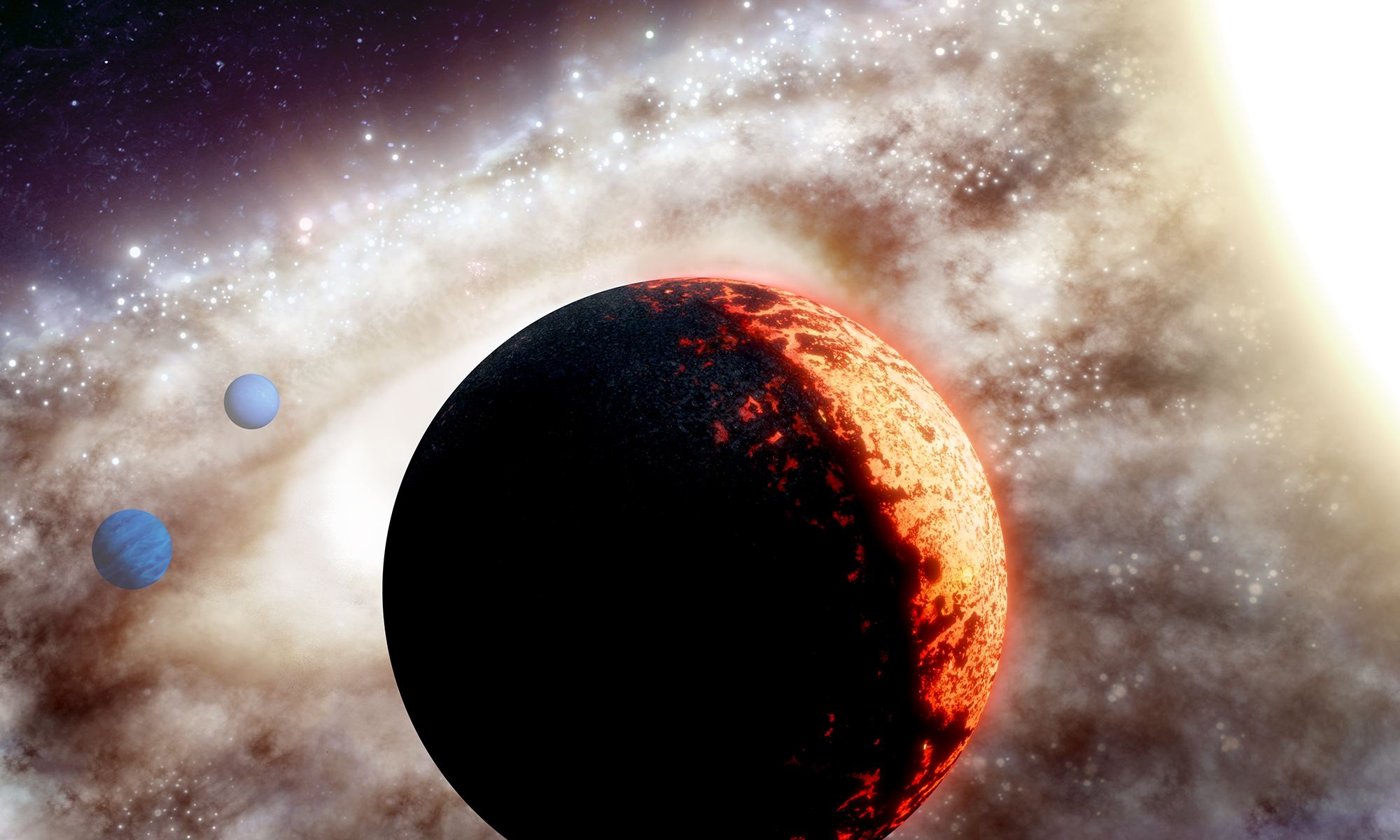
Would it be surprising to find a rocky planet that dates back to the very early Universe? It should be. The early Universe lacked the heavier elements necessary to form rocky planets.
But astronomers have found one, right here in the Milky Way.
Continue reading “One of the Oldest Stars in the Galaxy has a Planet. Rocky Planets Were Forming at Nearly the Beginning of the Universe”Astronomers Are Sure These Are Two Newborn Planets Orbiting a Distant Star

Planet formation is a notoriously difficult thing to observe. Nascent planets are ensconced inside dusty wombs that resist our best observation efforts. But recently, astronomers have made progress in imaging these planetary newborns.
A new study presents the first-ever direct images of twin baby planets forming around their star.
Continue reading “Astronomers Are Sure These Are Two Newborn Planets Orbiting a Distant Star”Astronomers Find a Planet With Three Times the Mass of Jupiter

Jupiter is the Boss.
Well, in terms of planets in our Solar System it is. It’s played a huge role in shaping the Solar System due to its mass and its gravity. Here’s a few ways it’s shaped our system:
Continue reading “Astronomers Find a Planet With Three Times the Mass of Jupiter”Milky Way’s Black Hole Just Flared, Growing 75 Times as Bright for a Few Hours

Even though the black hole at the center of the Milky Way is a monster, it’s still rather quiet. Called Sagittarius A*, it’s about 4.6 million times more massive than our Sun. Usually, it’s a brooding behemoth. But scientists observing Sgr. A* with the Keck Telescope just watched as its brightness bloomed to over 75 times normal for a few hours.
Continue reading “Milky Way’s Black Hole Just Flared, Growing 75 Times as Bright for a Few Hours”Astronomers Detect Water in the Atmosphere of a Planet 179 Light-Years Away
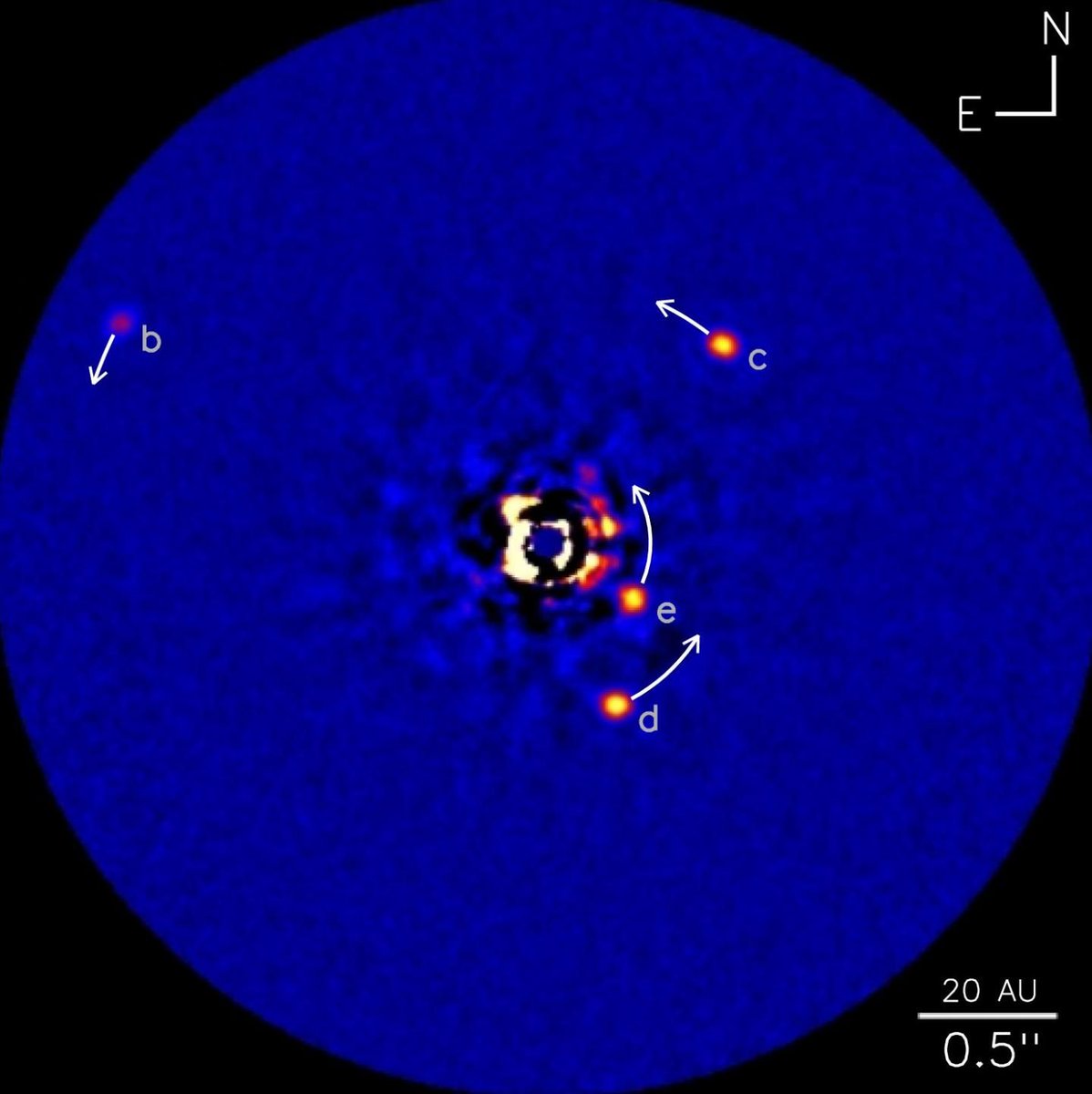
Gathering detailed information on exoplanets is extremely difficult. The light from their host star overwhelms the light from the exoplanet, making it difficult for telescopes to see them. But now a team using cutting-edge technology at the Keck Observatory has taken a big leap in exoplanet observation and has detected water in the atmosphere of a planet 179 light years away.
Continue reading “Astronomers Detect Water in the Atmosphere of a Planet 179 Light-Years Away”
Vortex Coronagraph A Game Changer For Seeing Close In Exoplanets
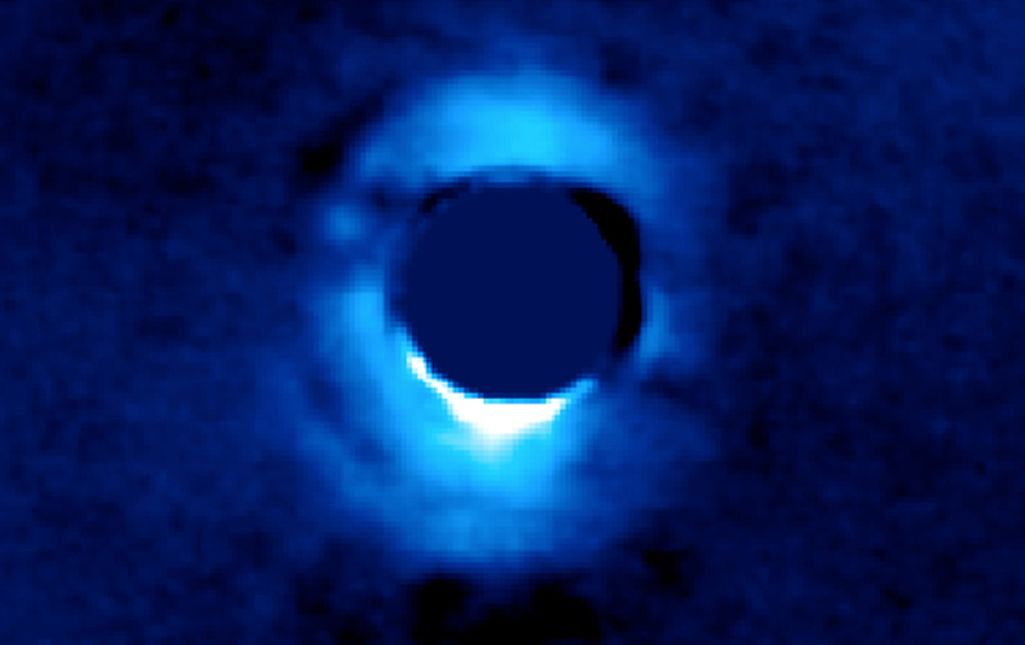
The study of exoplanets has advanced a great deal in recent years, thanks in large part to the Kepler mission. But that mission has its limitations. It’s difficult for Kepler, and for other technologies, to image regions close to their stars. Now a new instrument called a vortex coronagraph, installed at Hawaii’s Keck Observatory, allows astronomers to look at protoplanetary disks that are in very close proximity to the stars they orbit.
The problem with viewing disks of dust, and even planets, close to their stars is that stars are so much brighter than objects that orbit them. Stars can be billions of times brighter than the planets near them, making it almost impossible to see them in the glare. “The power of the vortex lies in its ability to image planets very close to their star, something that we can’t do for Earth-like planets yet,” said Gene Serabyn of NASA’s Jet Propulsion Laboratory (JPL). “The vortex coronagraph may be key to taking the first images of a pale blue dot like our own.”
“The power of the vortex lies in its ability to image planets very close to their star, something that we can’t do for Earth-like planets yet.” – Gene Serabyn, JPL.
“The vortex coronagraph allows us to peer into the regions around stars where giant planets like Jupiter and Saturn supposedly form,” said Dmitri Mawet, research scientist at NASA’s Jet Propulsion Laboratory and Caltech, both in Pasadena. “Before now, we were only able to image gas giants that are born much farther out. With the vortex, we will be able to see planets orbiting as close to their stars as Jupiter is to our sun, or about two to three times closer than what was possible before.”
Rather than masking the light of stars, like other methods of viewing exoplanets, the vortex coronagraph redirects light away from the detectors by combining light waves and cancelling them out. Because there is no occulting mask, the vortex coronagraph can capture images of regions much closer to stars than other coronagraphs can. Dmitri Mawet, research scientist who invented the new coronagraph, compares it to the eye of a storm.

“The instrument is called a vortex coronagraph because the starlight is centered on an optical singularity, which creates a dark hole at the location of the image of the star,” said Mawet. “Hurricanes have a singularity at their centers where the wind speeds drop to zero — the eye of the storm. Our vortex coronagraph is basically the eye of an optical storm where we send the starlight.”
The results from the vortex coronagraph are presented in two papers (here and here) published in the January 2017 Astronomical Journal. One of the studies was led by Gene Serabyn of JPL, who is also head of the Keck vortex project. That study presented the first direct image of HIP79124 B, a brown dwarf that is 23 AU from its star, in the star-forming region called Scorpius-Centaurus.
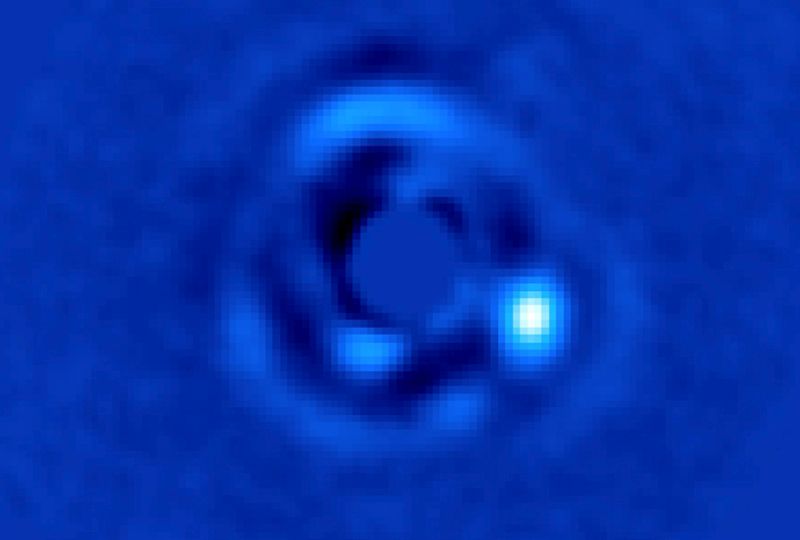
“The ability to see very close to stars also allows us to search for planets around more distant stars, where the planets and stars would appear closer together. Having the ability to survey distant stars for planets is important for catching planets still forming,” said Serabyn.
“Having the ability to survey distant stars for planets is important for catching planets still forming.” – Gene Serabyn, JPL.
The second of the two vortex studies presented images of a protoplanetary disk around the young star HD141569A. That star actually has three disks around it, and the coronagraph was able to capture an image of the innermost ring. Combining the vortex data with data from the Spitzer, WISE, and Herschel missions showed that the planet-forming material in the disk is made up pebble-size grains of olivine. Olivine is one of the most abundant silicates in Earth’s mantle.
“The three rings around this young star are nested like Russian dolls and undergoing dramatic changes reminiscent of planetary formation,” said Mawet. “We have shown that silicate grains have agglomerated into pebbles, which are the building blocks of planet embryos.”
These images and studies are just the beginning for the vortex coronagraph. It will be used to look at many more young planetary systems. In particular, it will look at planets near so-called ‘frost lines’ in other solar systems. The is the region around star systems where it’s cold enough for molecules like water, methane, and carbon dioxide to condense into solid, icy grains. Current thinking says that the frost line is the dividing line between where rocky planets and gas planets are formed. Astronomers hope that the coronagraph can answer questions about hot Jupiters and hot Neptunes.
Hot Jupiters and Neptunes are large gaseous planets that are found very close to their stars. Astronomers want to know if these planets formed close to the frost line then migrated inward towards their stars, because it’s impossible for them to form so close to their stars. The question is, what forces caused them to migrate inward? “With a bit of luck, we might catch planets in the process of migrating through the planet-forming disk, by looking at these very young objects,” Mawet said.
Eris’ Moon Dysnomia
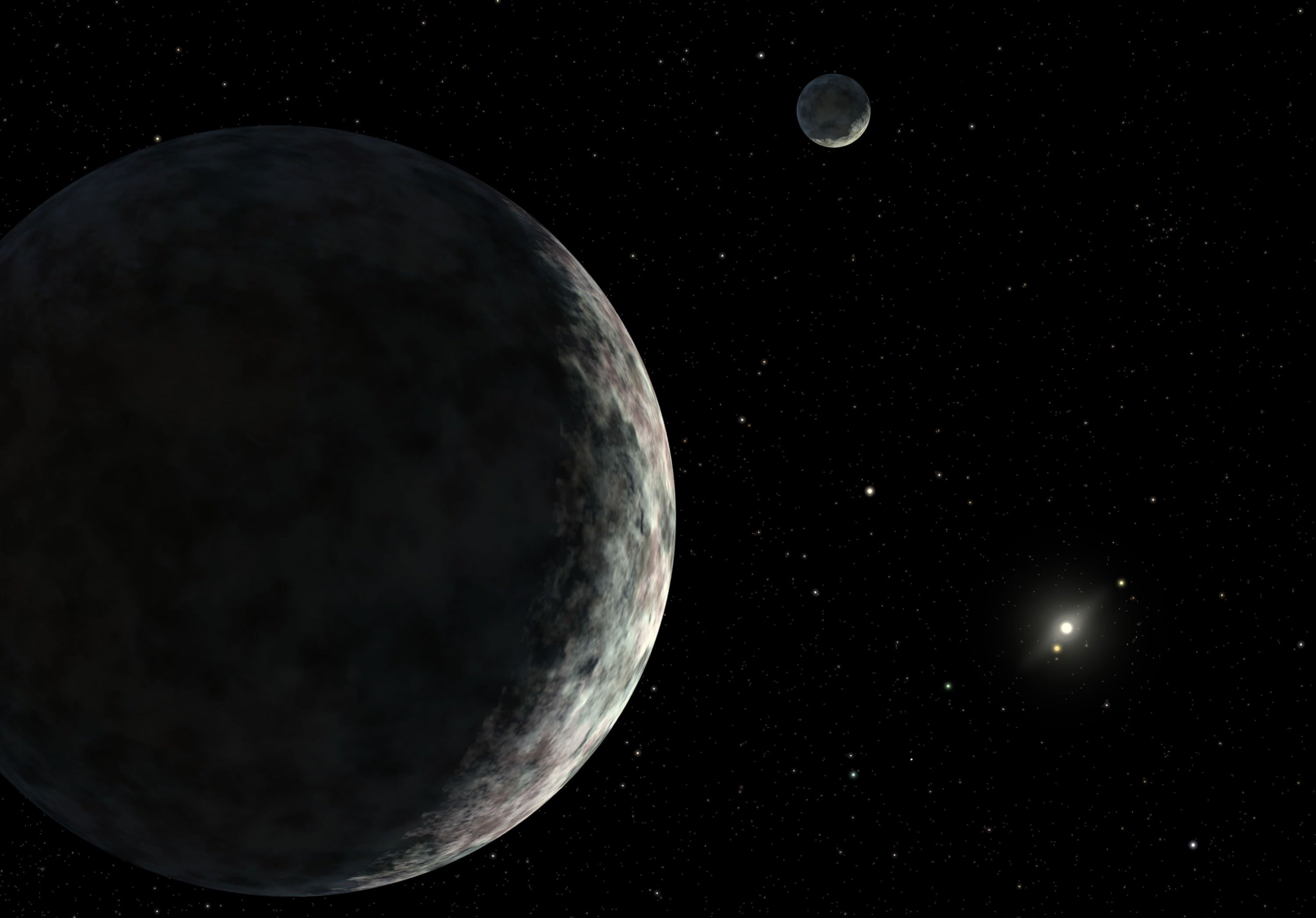
Ask a person what Dysnomia refers to, and they might venture that it’s a medical condition. In truth, they would be correct. But in addition to being a condition that affects the memory (where people have a hard time remembering words and names), it is also the only known moon of the distant dwarf planet Eris.
In fact, the same team that discovered Eris a decade ago – a discovery that threw our entire notion of what constitutes a planet into question – also discovered a moon circling it shortly thereafter. As the only satellite that circles one of the most distant objects in our Solar System, much of what we know about this ball of ice is still subject to debate.
Discovery and Naming:
In January of 2005, astronomer Mike Brown and his team discovered Eris using the new laser guide star adaptive optics system at the W. M. Keck Observatory in Hawaii. By September, Brown and his team were conducting observations of the four brightest Kuiper Belt Objects – which at that point included Pluto, Makemake, Haumea, and Eris – and found indications of an object orbiting Eris.
Provisionally, this body was designated S/2005 1 (2003 UB³¹³). However, in keeping with the Xena nickname that his team was already using for Eris, Brown and his colleagues nicknamed the moon “Gabrielle” after Xena’s sidekick. Later, Brown selected the official name of Dysnomia for the moon, which seemed appropriate for a number of reasons.
For one, this name is derived from the daughter of the Greek god Eris – a daemon who represented the spirit of lawlessness – which was in keeping with the tradition of naming moons after lesser gods associated with the primary god. It also seemed appropriate since the “lawless” aspect called to mind actress Lucy Lawless, who portrayed Xena on television. However, it was not until the IAU’s resolution on what defined a planet – passed in August of 2006 – that the planet was officially designated as Dysnomia.
Size, Mass and Orbit:
The actual size of Dysnomia is subject to dispute, and estimates are based largely on the planet’s albedo relative to Eris. For example, the IAU and Johnston’s Asteroids with Satellites Database estimate that it is 4.43 magnitudes fainter than Eris and has an approximate diameter of between 350 and 490 km (217 – 304 miles)
However, Brown and his colleagues have stated that their observations indicate it to be 500 times fainter and between 100 and 250 km (62 – 155 miles) in diameter. Using the Herschel Space Observatory in 2012, Spanish astronomer Pablo Santo Sanz and his team determined that, provided Dysnomia has an albedo five times that of Eris, it is likely to be 685±50 km in diameter.
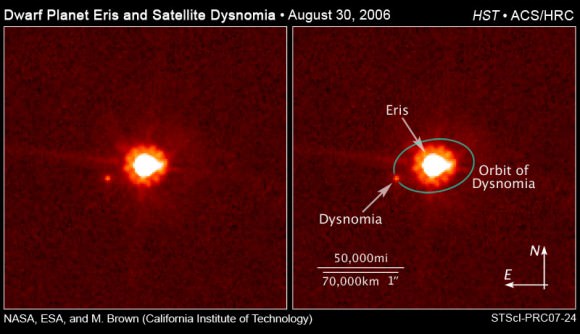
In 2007, Brown and his team also combined Keck and Hubble observations to determine the mass of Eris, and estimate the orbital parameters of the system. From their calculations, they determined that Dysnomia’s orbital period is approximately 15.77 days. These observations also indicated that Dysnomia has a circular orbit around Eris, with a radius of 37350±140 km. In addition to being a satellite of a dwarf planet, Dysnomia is also a Kuiper Belt Object (KBO) like Eris.
Composition and Origin:
Currently, there is no direct evidence to indicate what Dysnomia is made of. However, based on observations made of other Kuiper Belt Objects, it is widely believed that Dysnomia is composed primarily of ice. This is based largely on infrared observations made of Haumea (2003 EL61), the fourth largest object in the Kuiper Belt (after Eris, Pluto and Makemake) which appears to be made entirely of frozen water.
Astronomers now know that three of the four brightest KBOs – Pluto, Eris and Haumea – have one or more satellites. Meanwhile, of the fainter members, only about 10% are known to have satellites. This is believed to imply that collisions between large KBOs have been frequent in the past. Impacts between bodies of the order of 1000 km across would throw off large amounts of material that would coalesce into a moon.
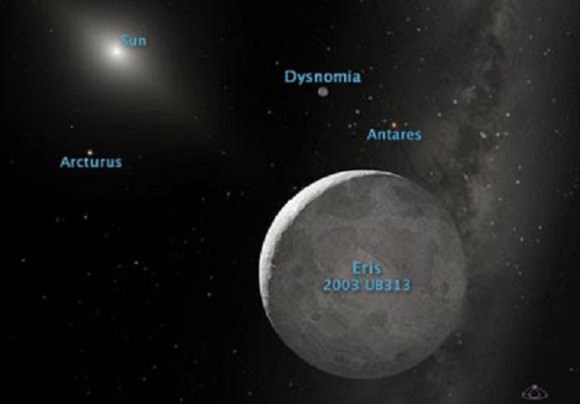
This could mean that Dysnomia was the result of a collision between Eris and a large KBO. After the impact, the icy material and other trace elements that made up the object would have evaporated and been ejected into orbit around Eris, where it then re-accumulated to form Dysnomia. A similar mechanism is believed to have led to the formation of the Moon when Earth was struck by a giant impactor early in the history of the Solar System.
Since its discovery, Eris has lived up to its namesake by stirring things up. However, it has also helped astronomers to learn many things about this distant region of the Solar System. As already mentioned, astronomers have used Dysnomia to estimate the mass of Eris, which in turn helped them to compare it to Pluto.
While astronomers already knew that Eris was bigger than Pluto, but they did not know whether it was more massive. This they did by measuring the distance between Dysnomia and how long it takes to orbit Eris. Using this method, astronomers were able to discover that Eris is 27% more massive than Pluto is.
With this knowledge in hand, the IAU then realized that either Eris needed to be classified as a planet, or that the term “planet” itself needed to be refined. Ergo, one could make that case that it was the discovery of Dysnomia more than Eris that led to Pluto no longer being designated a planet.
Universe Today has articles on Xena named Eris and The Dwarf Planet Eris. For more information, check out Dysnomia and dwarf planet outweighs Pluto.
Astronomy Cast has an episode on Pluto’s planetary identity crisis.
Sources:
Power Up! Distant Uranus Sees A Storm Surge Of ‘Monstrous’ Proportions
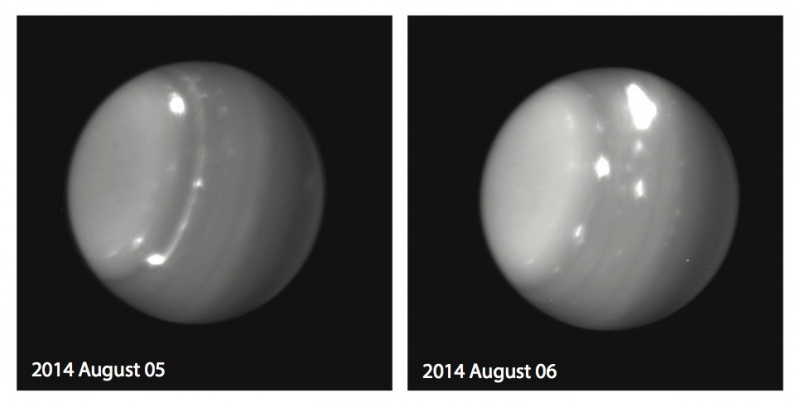
Who can imagine Uranus as a quiet planet now? The Keck Observatory caught some spectacular pictures of the gas giant undergoing a large storm surge a few days ago, which took astronomers by surprise because the planet is well past the equinox in 2007, when the sun was highest above the equator.
“We are always anxious to see that first image of the night of any planet or satellite, as we never know what it might have in store for us,” stated Imke de Pater, an astronomer at the University of California, Berkeley that led the research.
“This extremely bright feature we saw on UT 6 August 2014 reminds me of a similarly bright storm we saw on Uranus’s southern hemisphere during the years leading up to and at equinox.”
Astronomers say the brightest of the storms is “monstrous” and reminds them of a dissipated feature nicknamed the “Berg”, since it looked a bit like an iceberg.

The Berg, which might have been there when one of the Voyager spacecraft flew by in 1986, moved between the southern latitudes of 32 and 36 degrees between 2000 and 2005. After getting brighter in 2004, it moved towards the equator and got even stronger, where it remained until falling apart in 2009. (You can see pictures of it here.)
“The present storm is even brighter than the Berg. Its morphology is rather similar, and the team expects it may also be tied to a vortex in the deeper atmosphere,” Keck stated. Based on how bright the storm appears, researchers believe it must be reaching high into the atmosphere, perhaps approaching the tropopause (just below the stratosphere)
Source: Keck Observatory
Hubble Spots Farthest Lensing Galaxy Yet
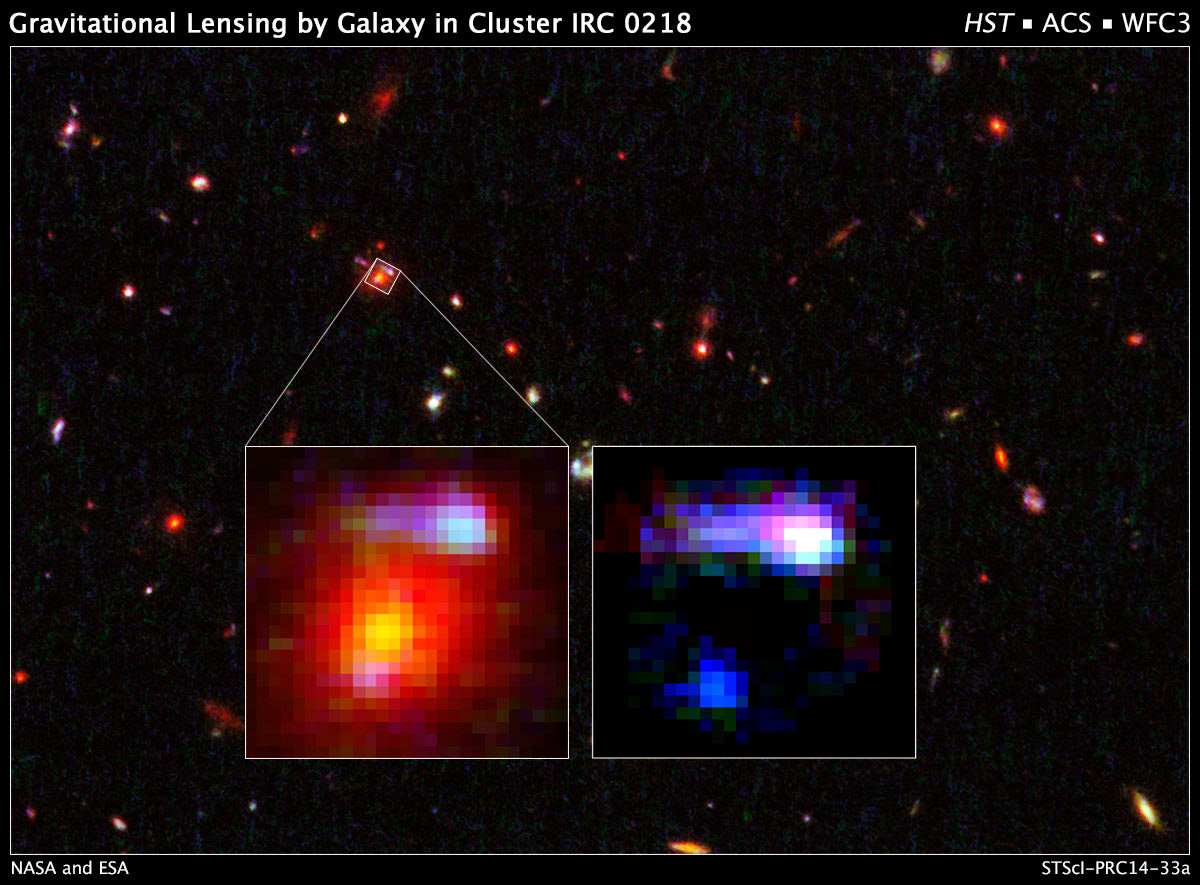
Sometimes there’s a chance alignment — faraway in the universe, where objects are separated by unimaginable distances measured in billions of light-years — when a galaxy cluster in the foreground intersects light from an even more distant object. The conjunction plays visual tricks, where the galaxy cluster acts like a lens, appearing to magnify and bend the distant light.
The rare cosmic alignment can bring the distant universe into view. Now, astronomers have stumbled upon a surprise: they’ve detected the most distant cosmic magnifying glass yet.
Seen above as it looked 9.6 billion years ago, this monster elliptical galaxy breaks the previous record holder by 200 million light-years. It’s bending, distorting and magnifying the distant spiral galaxy, whose light has taken 10.7 billion years to reach Earth.
“When you look more than 9 billion years ago in the early universe, you don’t expect to find this type of galaxy-galaxy lensing at all,” said lead researcher Kim-Vy Tran from Texas A&M University in a Hubble press release.
“Imagine holding a magnifying glass close to you and then moving it much farther away. When you look through a magnifying glass held at arm’s length, the chances that you will see an enlarged object are high. But if you move the magnifying glass across the room, your chances of seeing the magnifying glass nearly perfectly aligned with another object beyond it diminishes.”
The team was studying star formation in data collected by the W. M. Keck Observatory in Hawai’i, when they came across a strong detection of hot hydrogen gas that appeared to arise form a massive, bright elliptical galaxy. It struck the team as odd. Hot hydrogen is a clear sign of star birth, but it was detected in a galaxy that looked far too old to be forming new stars.
“I was very surprised and worried,” Tran recalled. “I thought we had made a major mistake with our observations.”
So Tran dug through archived Hubble images, which revealed a smeared, blue object next to the larger elliptical. It was the clear signature of a gravitational lens.
“We discovered that light from the lensing galaxy and from the background galaxy were blended in the ground-based data, which was confusing us,” said coauthor Ivelina Momcheva of Yale University. “The Keck spectroscopic data hinted that something interesting was going on here, but only with Hubble’s high-resolution spectroscopy were we able to separate the lensing galaxy from the more distant background galaxy and determine that the two were at different distances. The Hubble data also revealed the telltale look of the system, with the foreground lens in the middle, flanked by a bright arc on one side and a faint smudge on the other — both distorted images of the background galaxy. We needed the combination of imaging and spectroscopy to solve the puzzle.”
By gauging the intensity of the background galaxy’s light, the team was able to measure the giant galaxy’s total mass. All in all it weighs 180 billion times more than our Sun. Although this may seem big, it actually weighs four times less than the Milky Way galaxy.
“There are hundreds of lens galaxies that we know about, but almost all of them are relatively nearby, in cosmic terms,” said lead author Kenneth Wong from the Academia Sinica Institute of Astronomy & Astrophysics. “To find a lens as far away as this one is a very special discovery because we can learn about the dark-matter content of galaxies in the distant past. By comparing our analysis of this lens galaxy to the more nearby lenses, we can start to understand how that dark-matter content has evolved over time.”
Interestingly, the lensing galaxy is underweight in terms of its dark-matter content. In the past, astronomers have assumed that dark matter and normal matter build up equally in a galaxy over time. But this galaxy, suggests this is not the case.
The team’s results appeared in the July 10 issue of The Astrophysical Journal Letters and is available online.

